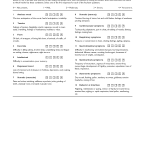
 Hamilton Anxiety Scale
Hamilton Anxiety Scale
The Hamilton Anxiety Rating Scale (HAM-A) is a psychological questionnaire used by clinicians to rate the severity of a patient’s anxiety. Anxiety can refer to things such as “a mental state…a drive…a response to a particular situation…a personality trait…and a psychiatric disorder.” Though it was one of the first anxiety rating scales to be published, the HAM-A remains widely used by clinicians. It was originally published by Max Hamilton in 1959. For clinical purposes, and the purpose of this scale, only severe or improper anxiety is attended to. This scale is considered a “clinical rating” of the extensiveness of anxiety, and is intended for individuals that are “already diagnosed with anxiety neurosis.” The scale consists of 14 items designed to assess the severity of a patient’s anxiety. Each of the 14 items contains a number of symptoms, and each group of symptoms is rated on a scale of zero to four, with four being the most severe. All of these scores are used to compute an overarching score that indicates a person’s anxiety severity.[4] The Hamilton Anxiety Rating scale has been considered a valuable scale for many years, but the ever-changing definition of anxiety, new technology, and new research has had an effect on the scale’s perceived usefulness. As a result, there have been changes, and challenges, to the original version of the scale over time.
